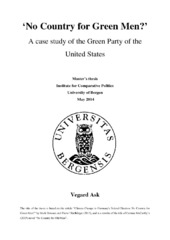| dc.description.abstract | The purpose of this thesis is to explore the following question: Why has the Green Party of the United States not been more successful in the political arena?" This question is again related to two broader questions; why are some green parties successful, while others are not? And why are minor parties in the United States, like the Green Party, in general not successful? In the thesis I present several different explanations for the lack of success of minor political parties (in general). Basically I argue that the different explanations can be separated into three broad categories; the political system, the electorate and the political party itself. In regard to the political system, electoral law especially has proven to have a major impact on party system. In addition, party laws, campaign financing and ballot access regulations also have some impact. On the electorate I explore primarily two contrasting theories concerned with explaining how voters act; the cleavage model by Seymour M. Lipset and Stein Rokkan (1967) and Anthony Downs' (1985 (1957)) theory of rational action and the rational voter. When it comes to the political party I, based on the research by Kaare Strøm and Wolfgang C. Müller (1999), show how parties may operate with different goals, being either office- seeking, voter-seeking or policy-seeking, and how the goals of a party may have consequences for the electoral outcome. Additionally, I also present Thomas Poguntke and Paul Webb's (2005) theory on how political parties have to respond to the increasing focus in campaigns on candidates, rather than parties. In short my conclusion is that the Green Party's relative lack of success in the United States is related to not just one, but several different factors. First and foremost, the plurality electoral system utilized in the United States is the main culprit so to speak. Not only does it effectively make it harder for minor parties, like the Green Party, to win seats in Congress or members of the Electoral Colleague, but it also has an effect on how the electorate vote and reason. In addition, factors like complicated ballot access laws, lack of a proper system of public campaign financing for minor parties, several challenges with the party itself, like difficulties with attracting enough good candidates willing to run for the party, and a slight lack of interest for environmentalism among the United States' citizens, all do their part to make it difficult for the Green Party to achieve major success. | en_US |
